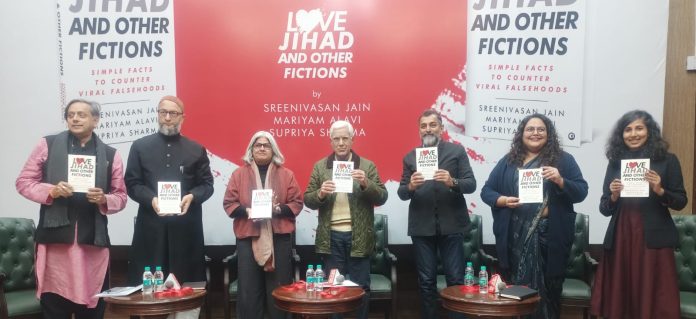Radiance News
New Delhi, Feb. 1: Love Jihad and Other Fictions: Simple Facts to Counter Viral Falsehoods by Sreenivasan Jain, Mariyam Alavi and Supriya Sharma, which debunks the conspiracy theories and false narratives against Love Jihad, Forced Conversion and Population Jihad, was released here Wednesday.
In this book, the authors who are journalists have addressed popular conspiracy theories and tried to substantiate their claims through facts, official records, and interviews. They have attempted to dispel the myths that have become part of our daily life conversations.
Sreenivasan Jain, while replying to a question by the senior journalist Karan Thapar who was moderating the program, said, “Our idea was to put together something which acts as a sort of anti-guide for those who may be interested in pushing back against this tiny wave of false narrative against love Jihad, whether you’re a citizen, whether you’re a journalist, whether you’re in the world of politics, that when you’re confronted with this, you have a sort of one-stop text which you can refer to do your little bit in encompassing this very dangerous phenomenon which is in our country.”
During the panel discussion, AIMIM chief Asaduddin Owaisi said, “I don’t know whether this book will stop the Hindutva forces from spreading lies and hate. What can stop Hindutva forces, BJP and Sangh Parivar is a counter-narrative. We don’t have a counter-narrative. We don’t have a base to put forward and deliver things in this work of propaganda.”
In reply to a question, on how to build counter-narrative, Owaisi said there are many ways to do it. Citing examples, he said that when the minority character of AMU is being questioned, secular parties are silent instead of raising their voice that it is a minority institution. On 22 January no secular parties raised the issue of demolition of Babri Masjid as a counter-narrative because of losing Hindu votes.
Commenting on the book, Congress leader Shashi Tharoor said, “The most impressive thing about the book is the meticulousness of the research. The authors have actually gone and looked into very specific cases. And when it comes to larger statistical issues as in the population in one chapter, they have done thorough research and an extremely unusual work in the Indian context because we tend and I probably think you’ll too, of using information without substantiating the facts. This is like a reference.”
Tharoor also said his party has always raised issues that are important for people and minorities and will continue to do so.
Senior Supreme Court lawyer Vrinda Grover said a lot of these things now that we tested in society, “I am not sure that the court is the best place to test everything anymore.” According to her many such laws which are in place have been challenged in the courts.
The authors in this book have interrogated some theories that are part of the landscape of WhatsApp chats and social media feeds of millions of Indians every day. Chapter 1 examines ‘love jihad’, perhaps the most ascendant of all these claims. Starting with the first known case of ‘love jihad’, the authors investigate arguably the only definitive list of ‘love jihad’ cases. They travel to the state where the largest number of arrests have been made under new anti-love jihad laws to explore if the crackdown is justified.
Chapter 2 places ‘population jihad’ – the claim that Muslims are waging a holy war by producing more children – under the scanner. The authors crunch the numbers and trawl through parliamentary records to decode whether Muslims will indeed outnumber over a billion Hindus in the near future.
Chapter 3 scrutinizes the Hindutva claim of a sinister Christian scheme to take over India through mass forced conversions.
Chapter 4 examines the theory of Muslim appeasement, probing assertions like unequal availability of electricity on Diwali and Eid, the Hajj subsidy, funds to madrasas, and the favourite bugbear of the Hindu Right: Muslim men being able to take up to four wives.




